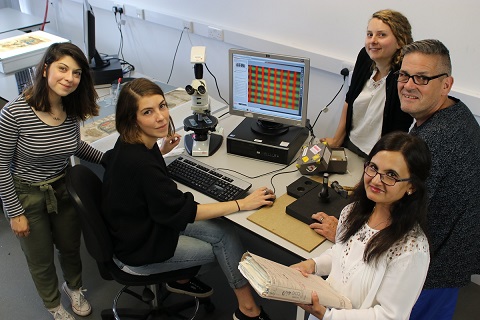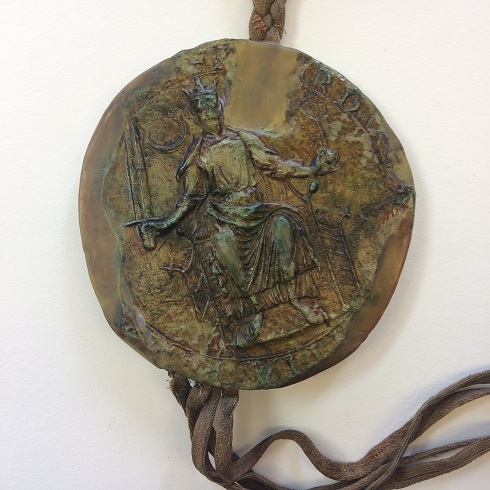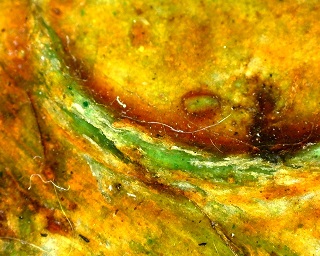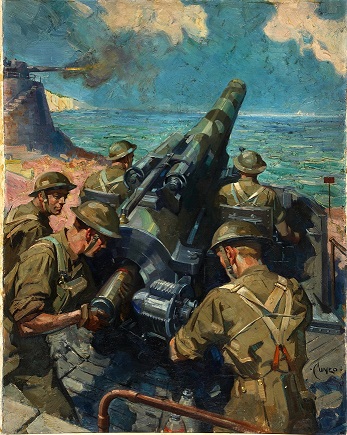The National Archives has a loans programme manned by a small dedicated team within the Collection Care Department. A team coordinator, two conservators, a conservation technician and a registrar handle everything from the initial requests to the successful installation and de-installation of our exhibitions, and aim at spreading the riches of our collections beyond our archival borders.
The team facilitates the loan of around 40 documents a year, mostly within the UK and continental Europe but also to the more distant horizons of Canada, the USA and Australia.

The loans and exhibitions team hard at work
All our loans are escorted or couriered by a member of the team who will oversee the installation and de-installation of each exhibition. Beyond being motivated by a love of our collections, it is also an exciting opportunity to travel to different public and private institutions, nationally and internationally – a perk of the job, even if it involves travelling in an art handler’s lorry for many hours!
All loan preparations are performed on site at The National Archives. Our team coordinator manages the activities and communications, ensuring we fulfil our responsibilities to document care. Our art registrar acts as first point of contact, schedules meetings, monitors progress and expenses, liaises with the National Security Adviser and insurance companies, organises transport – the list is long. Our conservation technician devises packing solutions to make sure all our precious documents will be protected at all times – he even sometimes makes miniature models of transport crates to make sure the conservators put everything back into the right place and order!
In parallel, the conservators liaise with the borrowing institutions to make sure the best display conditions can be met in terms of lighting, temperature, relative humidity and security. Those parameters are object-specific and we strive to find a balance between sharing our historical and artistic patrimony with wider audiences and a greatly felt responsibility to safeguard irreplaceable national heritage for generations to come.
We also carry out detailed condition reports and any conservation treatment needed to give each document a clean bill of health before it is sent off. This ensures each document or artwork is looking its best and, most importantly, will withstand handling, travelling and being on display over the course of several weeks or months.
Richard I’s Great Seal
We recently looked at Richard I’s great seal under the microscope to see if it was fit for loan and display. Detailed assessments not only allow the minute monitoring of an object’s condition (and changes thereof) but also a greater and intimate understanding of our collections in general and each item in particular:
- What makes our collections?
- What is an object made of?
- How does this inform the conservation and care of documents?
- What does a piece’s material history teach us about history in the broad sense of the term?
This knowledge can in turn inform display conditions.
- Richard I’s seal (detail of charter, catalogue reference: DL 10/47)
- Richard the Lionheart’s seal scrutinized using a Dino Lite USB microscope
- White, green and varnish layers on Richard the Lionheart’s seal
The uneven colour and patchy appearance of the seal made us think it might be particularly sensitive to light, temperature or relative humidity and thus prone to discolouration and degradation. Studying the seal’s stratigraphy taught us that green paint had been originally applied straight onto white wax. It had then been varnished and repaired on several (much later) occasions, giving it a concerning but non-threatening brown hue. The mighty Lionheart’s complexion was deemed stable enough to make a public appearance in Germany this autumn.
Terence Cuneo’s artworks
The team has also lately been working on several artworks by British artist Terence Cuneo, who was commissioned by the government to create a series of striking works illustrating the efforts of the Resistance during World War II.
- Coastal battery scene, by Terence Cuneo 1939-1946 (catalogue reference: INF3-21)
- Consolidation of a crack in the oil paint: a weak adhesive is inserted under the crack
- Consolidation of a crack in the oil paint: the edges of the crack are gently pushed down to reduce the gap
There was some concern that they might not be able to withstand vertical display or vibrations during transport. Cracks and flakes in the gouache and oil-paint have been minutely consolidated under a microscope using a 0000 brush and a weak adhesive – methylcellulose on the gouache and isinglass (made from the swim bladders of fish) on the oil paint – to prevent any losses. They will subsequently be mounted, framed and packed in our studio before travelling to Yorkshire.
We proudly protect and conserve our collection, but also gladly share!
View a list of selected exhibitions.





